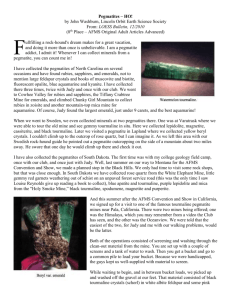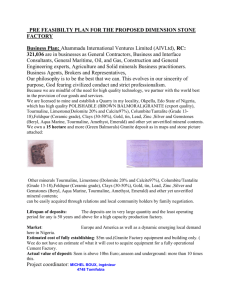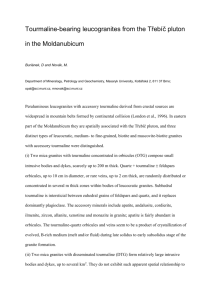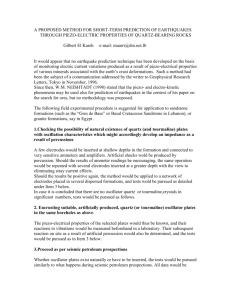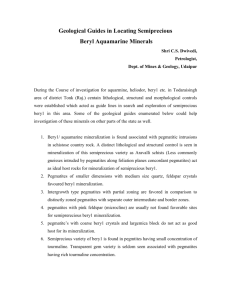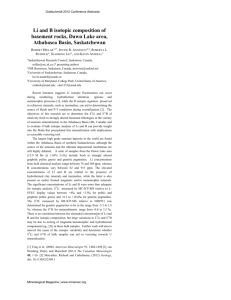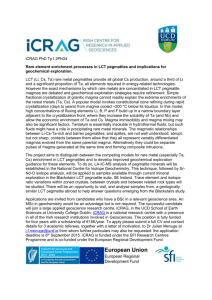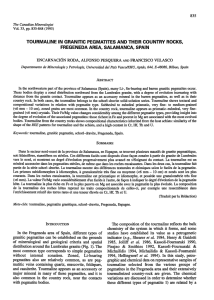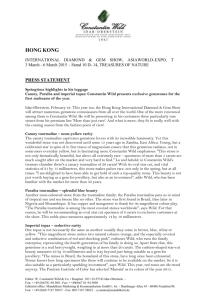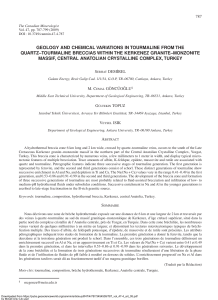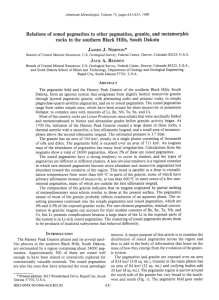Tourmaline from the NYF pegmatites of the Třebíč
advertisement
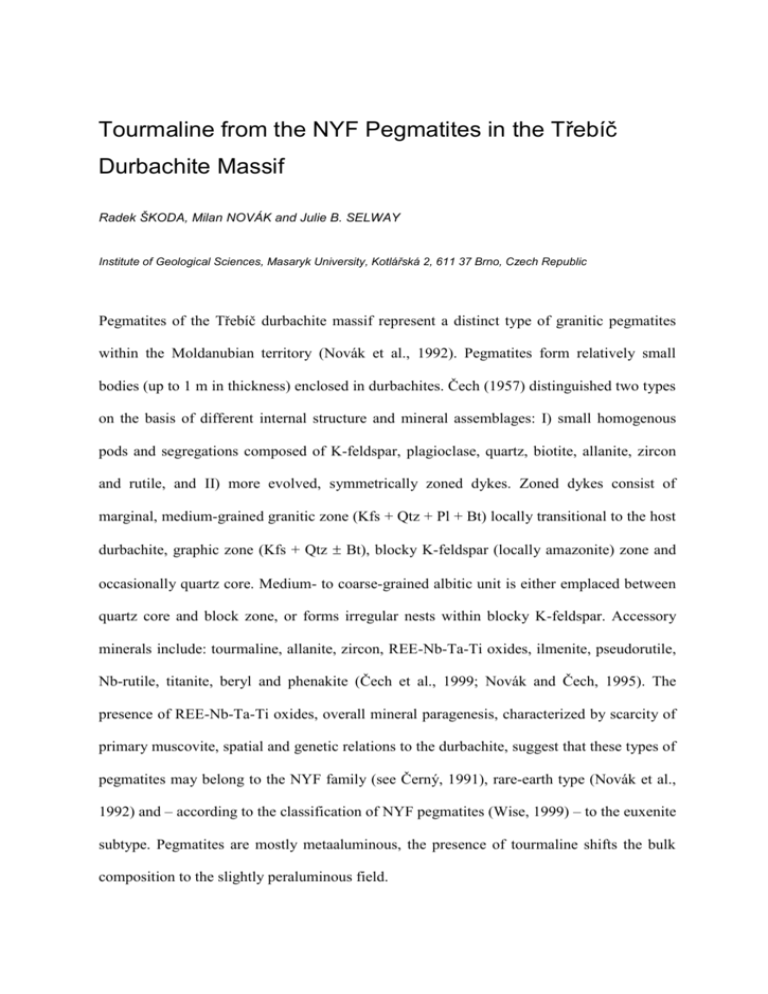
Tourmaline from the NYF Pegmatites in the Třebíč Durbachite Massif Radek ŠKODA, Milan NOVÁK and Julie B. SELWAY Institute of Geological Sciences, Masaryk University, Kotlářská 2, 611 37 Brno, Czech Republic Pegmatites of the Třebíč durbachite massif represent a distinct type of granitic pegmatites within the Moldanubian territory (Novák et al., 1992). Pegmatites form relatively small bodies (up to 1 m in thickness) enclosed in durbachites. Čech (1957) distinguished two types on the basis of different internal structure and mineral assemblages: I) small homogenous pods and segregations composed of K-feldspar, plagioclase, quartz, biotite, allanite, zircon and rutile, and II) more evolved, symmetrically zoned dykes. Zoned dykes consist of marginal, medium-grained granitic zone (Kfs + Qtz + Pl + Bt) locally transitional to the host durbachite, graphic zone (Kfs + Qtz Bt), blocky K-feldspar (locally amazonite) zone and occasionally quartz core. Medium- to coarse-grained albitic unit is either emplaced between quartz core and block zone, or forms irregular nests within blocky K-feldspar. Accessory minerals include: tourmaline, allanite, zircon, REE-Nb-Ta-Ti oxides, ilmenite, pseudorutile, Nb-rutile, titanite, beryl and phenakite (Čech et al., 1999; Novák and Čech, 1995). The presence of REE-Nb-Ta-Ti oxides, overall mineral paragenesis, characterized by scarcity of primary muscovite, spatial and genetic relations to the durbachite, suggest that these types of pegmatites may belong to the NYF family (see Černý, 1991), rare-earth type (Novák et al., 1992) and – according to the classification of NYF pegmatites (Wise, 1999) – to the euxenite subtype. Pegmatites are mostly metaaluminous, the presence of tourmaline shifts the bulk composition to the slightly peraluminous field. Tourmalines from three localities (Klučov, Terůvky and Pozďátky) were studied and three distinct morphological types were recognized. (i) The most abundant black, prismatic tourmaline (up to 3 cm) occurs in the blocky zone at all localities (Klučov, Terůvky, Pozďátky). (ii) Graphic intergrowths with quartz (in the block zone) and (iii) lath-shaped crystals in the albitized block zone occur only at Klučov. In the BSE image, tourmaline looks relatively homogenous, occasionally with Al-enriched rims, only lath-shaped tourmaline (iii) shows patchy zoning and encloses grains of quartz, feldspar, ilmenite and Ca, REE phosphate. Electron microprobe data were recalculated on bases of 31 anions, contents of B2O3 and H2O were determined by stoichiometry, B = 3, OH+F = 4. Prismatic tourmaline (i): the X-site is characterized by high content of Ca (up to 0.40 apfu) and low vacancy (<0.2 pfu). High Fe up to 2.08 apfu and Mg up to 2.17 apfu are dominant in the Y-site, but high contents of Ti (up to 0.42 apfu) were also recorded. Altot is commonly <6, hence Mg (and/or Fe3+) enter the Z-site (<0.95 apfu). Tourmaline from graphic intergrowths (ii): the X-site is mainly occupied by Na (0.61–0.79 apfu), content of Ca is minor (< 0.09 apfu). In the Y-site, Fe prevails (1.59–2.94 apfu), the contents of Mg and Ti are negligible (0.07–0.12 and 0.08–0.13 apfu, respectively), Mn varies from 0.11 to 0.43 apfu, YAl ranges from 0.02 to 0.66 apfu. The Z-site is completely filled by Al. Lath-shaped tourmaline (iii) has similar composition to that of prismatic tourmaline, differing only in higher contents of Fe (2.37–3.15 apfu) and lower amounts of Ca (0.10–0.17 apfu). The pegmatites of the Třebíč durbachite massif with minor tourmaline represent a rare example of the NYF pegmatites. (i) Prismatic Al-poor and Ti-rich tourmaline (Fe-rich dravite to Mg-rich schorl) has the chemical composition different from that of other black tourmalines from Moldanubian pegmatites. (ii) Tourmaline in graphic intergrowths (schorl) is more evolved than the prismatic one, and is characterized by higher amounts of Al, Fe, Mn and low content of Mg. (iii) Lath-shaped tourmaline from albite is probably formed by replacement of biotite during hydrothermal stage. References ČECH F., 1957. Příspěvek k poznání pegmatitů v třebíčsko-velkomeziříčském masivu. I. Čas. Morav. Mus., 42: 39-47. ČECH F. et al., 1999. Nb-Ta-Ti-REE oxides from NYF granitic pegmatites in the Třebíč durbachite massif, Czech Republic. Canad. Mineral., 37: 811-812. ČERNÝ P., 1991. Rare-element granitic pegmatites. I. Anatomy and internal evolution of pegmatite deposits. Geosci. Canada, 18: 49-67. NOVÁK M. et al., 1992. Granitic pegmatites in the territory of the Moravian and Bohemian Moldanubicum. In: Lepidolite 200, Intern. Symp. on the Mineralogy, Petrology and Geochemistry of Granitic Pegm., Field Trip Guidebook, pp. 11-20. NOVÁK M. and ČECH F., 1995. Scandian columbite and niobian rutile from pegmatites penetrating the Třebíč durbachite massif, Western Moravia, Czech Republic. Acta. Mus. Moraviae, Sci. nat., 80: 3-8.
